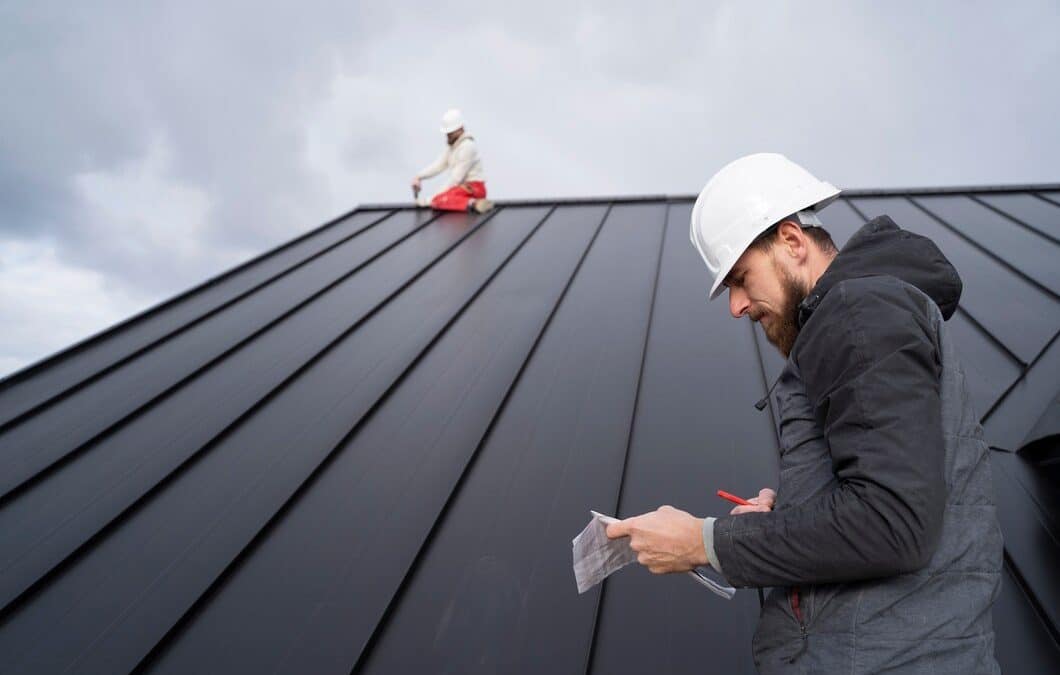PVC roofing is a popular choice for commercial buildings due to its durability, energy efficiency, and ease of installation. However, like any roofing material, PVC roofs can develop problems over time. Identifying and solving these problems early is crucial to maintaining the roof’s integrity and extending its lifespan. Effective maintenance can save your business from costly repairs and potential downtime.
Preventative maintenance is the key to maximizing the life of your PVC roof. Implementing a regular maintenance schedule can help you address minor issues before they grow, ensuring your roof remains in excellent condition for years to come. Let’s delve deeper into each of these aspects to keep your commercial PVC roof performing its best.
Common Signs of Problems in PVC Roofing
Identifying problems in your commercial PVC roofing early can save you from extensive and costly repairs. Look for these common signs of trouble:
- Leaks and Water Stains: One of the most obvious signs of a problem is water leakage or stains on the ceiling beneath the roof. These indicate that water is penetrating the roofing membrane.
- Ponding Water: After heavy rainfall, inspect for standing water on the roof surface. Ponding water can weaken the roofing material, leading to leaks and other issues.
- Blisters and Bubbles: Blisters or bubbles in the roofing membrane can indicate trapped moisture or air pockets. These need to be addressed promptly to prevent further damage.
- Loose or Detached Seams: Inspect the seams of the PVC roofing. If you find loose or detached seams, it could lead to water infiltration, undermining the roof’s integrity.
- Punctures and Tears: Sharp objects or heavy foot traffic can cause punctures and tears in the PVC membrane. These should be repaired immediately to prevent moisture ingress.
- Fading or Brittle Areas: Over time, exposure to UV rays can cause the PVC material to fade or become brittle. This degradation can compromise the roof’s protective qualities.
Steps to Inspect a Commercial PVC Roof
Regular inspections are vital for maintaining the health of your commercial PVC roof. Follow these steps to conduct a thorough inspection:
1. Prepare for Safety: Before starting, ensure you have the necessary safety equipment, including a harness, sturdy shoes, and gloves. Safety should always be the top priority.
2. Review Roofing Records: Check past maintenance records to be aware of any recurring problems or previous repairs. This can give you a better idea of common trouble spots.
3. Visual Inspection:
- Survey the Exterior: Walk the perimeter of the building to look for signs of wear or damage from the ground. This includes checking for sagging areas and exterior water stains.
- Inspect Surface: Climb onto the roof and conduct a detailed surface inspection. Look for debris, ponding water, and any visible signs of damage like cracks, punctures, and blisters.
- Check Seams and Flashing: Pay close attention to the seams and flashing. Ensure they are intact and securely adhered to the roof surface. Loose seams and damaged flashing can be entry points for water.
4. Assess Roof Penetrations: Inspect areas around roof penetrations such as vents, skylights, and HVAC units. These spots are particularly susceptible to leaks.
5. Interior Inspection: Check the building’s interior for signs of roof damage, like water stains or mold growth. These can be indicators of leaks or moisture ingress.
6. Documentation: Take photos and notes of any issues or potential problem areas you find. This documentation is useful for planning repairs and future inspections.
Effective Repair Techniques for PVC Roofing Issues
Repairing PVC roofing promptly and effectively is crucial to maintaining its durability and performance. Here’s a guide to addressing common PVC roofing problems:
- Fixing Leaks: Identify the source of the leak by tracing the water back to its entry point. Once located, clean the area thoroughly and apply a PVC-compatible patch. Use an adhesive designed for PVC roofing to ensure a watertight seal.
- Patching Small Holes and Tears: Clean the damaged area and cut a patch from spare PVC membrane material that is slightly larger than the tear. Apply a primer around the tear, and then attach the patch using PVC-specific adhesive. Use a roller to ensure the patch adheres firmly and remove air bubbles.
- Seam Repairs: Inspect the seams for any signs of separation or damage. Clean the area and heat-weld a new piece of membrane over the damaged seam. Ensure the welding tool is set to the correct temperature to avoid damaging the existing membrane.
- Repairing Blisters and Bubbles: Carefully cut open the blister or bubble to release the trapped air or moisture. Allow the area to dry, then apply a patch over the slit using PVC adhesive.
- Addressing Surface Cracks: For surface cracks, clean the area and apply PVC roof sealant. Spread it evenly using a putty knife to cover the crack completely and prevent water infiltration.
Preventative Maintenance Tips for Longevity
Regular maintenance is key to extending the life of your commercial PVC roof. Follow these preventative tips to keep your roof in top condition:
- Scheduled Inspections: Conduct bi-annual inspections, preferably in the spring and fall, to catch any emerging issues before they become serious. Inspections should also be done after major weather events.
- Clean Regularly: Remove debris such as leaves, branches, and dirt from the roof surface to prevent water pooling and potential damage. Clean the roof with a soft brush and mild detergent to maintain its reflective properties.
- Maintain Drainage Systems: Ensure gutters and downspouts are free of blockages to allow proper water drainage. Clear any debris and check for signs of wear or damage regularly.
- Monitor Seams and Flashing: Regularly check the seams and flashing for signs of damage or wear. Promptly address any issues to maintain a watertight seal.
- Limit Roof Traffic: Minimize foot traffic on the roof to prevent damage, and use walkways or mats in areas that require regular access for HVAC maintenance or other activities.
- Trim Overhanging Trees: Trim tree branches that overhang the roof to reduce the risk of falling debris and potential punctures or abrasions.
Conclusion
Maintaining a commercial PVC roof involves regular inspections, timely repairs, and ongoing preventative care. Identifying and addressing issues early ensures the roof remains in top condition, protecting your investment and minimizing downtime for your business. By keeping the roof clean, maintaining drainage systems, and limiting foot traffic, you can prevent many common problems and maintain the integrity of the roofing membrane. With a proactive approach, you can maximize the roof’s lifespan and performance.
For professional PVC roofing services, reach out to Mike Huddleston Roofing Systems. Our team is dedicated to providing top-quality roofing solutions tailored to your needs. Contact us today to schedule an inspection or learn more about our services!

